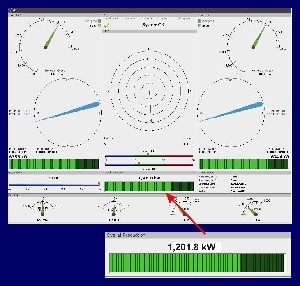
SeaGen Tidal Energy System Reaches
Full Power - 1.2MW
Dec 18, 2008 - MarineTurbine.com
Strangford Narrows, Northern Ireland: SeaGen, the
world’s first commercial scale tidal stream turbine,
designed and developed by British tidal energy company,
Marine Current Turbines, has for the first time generated
at its maximum capacity of 1.2MW. This is the highest
power so far produced by a tidal stream system anywhere
in the world and exceeds the previous highest output
of 300kW produced in 2004 by Marine Current Turbines’
earlier SeaFlow system, off the north Devon coast.
The image above shows a screen grab from SeaGen's
control system display with 1,201.8 kW being delivered
into the NI grid.
SeaGen works in principle much like an “underwater
windmill”, with the rotors driven by the power of
the tidal currents rather than the wind. It was deployed
in Northern Ireland’s Strangford Lough in May of this
year and since then has undergone commissioning trials.
As SeaGen has now reached full power it will move
towards full-operating mode, for periods of up to
22 hours a day, with regular inspections and performance
testing undertaken as part of the project’s development
programme. The testing programme for SeaGen is being
validated by the international marine classification
society DNV (Det Norsk Veritas).
The power generated by SeaGen is being purchased
by Irish energy company, ESB Independent, for its
customers in Northern Ireland and the Republic of
Ireland. SeaGen has the capacity to generate power
to meet the average electricity needs of around 1000
homes.
Martin Wright, Managing Director of Marine Current
Turbines said: “Generating at full power is an important
milestone for the company, and in particular our in-house
engineering team. We are very pleased with SeaGen’s
performance during commissioning. It demonstrates,
for the first time, the commercial potential of tidal
energy as a viable alternative source of renewable
energy. SeaGen is now running exactly as we said it
would, but testing will continue to be carried out,
not only to check SeaGen’s performance over extended
periods of operation but also to evaluate how components
are standing up to the harsh conditions and to determine
how the design might be improved. This work is vital
for SeaGen’s long-term commercial deployment in projects
elsewhere in the UK and overseas.”
“Marine Current Turbines has pioneered the development
of tidal current turbines. As the first mover in tidal
stream turbine development, we have a significant
technical lead over all rival tidal technologies that
are under development. There are no other tidal turbines
of truly commercial scale; all the competitive systems
so far tested at sea are quite small, most being less
than 10% the rotor area of SeaGen.”
Drawing on its experience of Strangford Lough, Marine
Current Turbines’ next project, announced in February
2008, is a joint initiative with npower renewables
to take forward a 10.5MW project using seven SeaGen
turbines off the coast of Anglesey, north Wales. It
is hoped the tidal farm will be commissioned around
2011/2012.
Using its SeaGen technology, the company is also
investigating the potential for tidal energy schemes
in other parts of the UK and Ireland, and in North
America.
Notes to Editors:
1. Marine Current Turbines Ltd (www.marineturbines.com)
is based in Bristol, England. The company was established
in 2000 and its principal corporate shareholders include
BankInvest, ESB International, EDF Energy, Guernsey
Electricity and Triodos Bank. In September 2008, MCT
was ranked in The Guardian/Library House Top 10 of
European clean-tech firms. In November 2008, the company
appointed Cavendish Corporate Finance to secure new
investment in the company in order to take forward
its development plans.
2. SeaGen works by generating power from sea currents,
using a pair of axial flow turbines driving generators
through gearboxes using similar principles to wind
generator technology. The main difference is that
the high density of seawater compared to wind allows
a much smaller system; SeaGen has twin 600kW turbines
each of 16m diameter. The capture of kinetic energy
from a water current, much like with wind energy or
solar energy, depends on how many square meters of
flow cross-section can be addressed by the system.
With water current turbines it is rotor swept area
that dictates energy capture capability, because it
is the cross section of flow that is intercepted which
matters. SeaGen has over 400 square meters of rotor
area which is why it can develop its full rated power
of 1.2MW in a flow of 2.4m/s (5 knots).
3. The SeaGen project has received £5.2m of funding
from the UK Government. In addition, Northern Ireland
Electricity has provided funding of £500,000 for the
project as part of NIE Smart. NIE Smart (Sustainable
Management of Assets and Renewable Technologies) encourages
the development of renewable energy and energy efficient
alternatives throughout Northern Ireland.
For further information:
Marine Current Turbines
Martin Wright, Managing Director
Tel: +44 (0)117 979 1888 / +44 (0)7785 340671
or
Paul Taylor
Taylor Keogh Communications
T: +44 (0) 203 170 8465 / DDI: +44 (0)203 170 8466
M: +44 (0)7966 782611
E: paul@taylorkeogh.com
W: www.taylorkeogh.com

|



